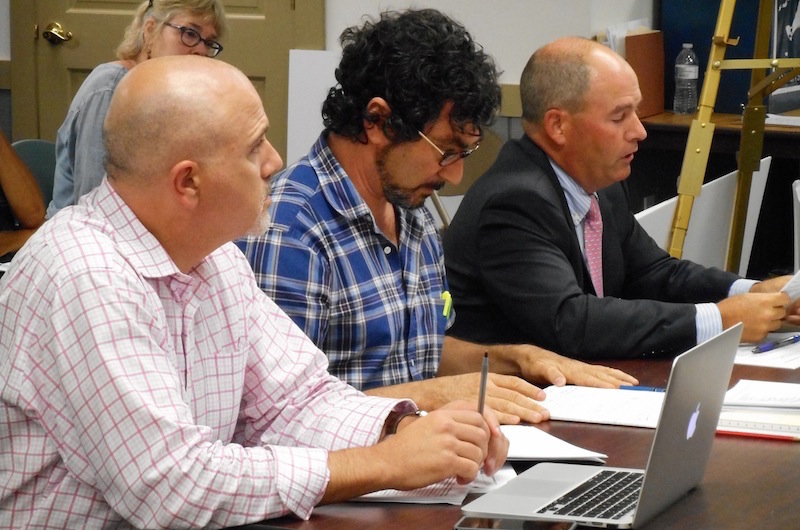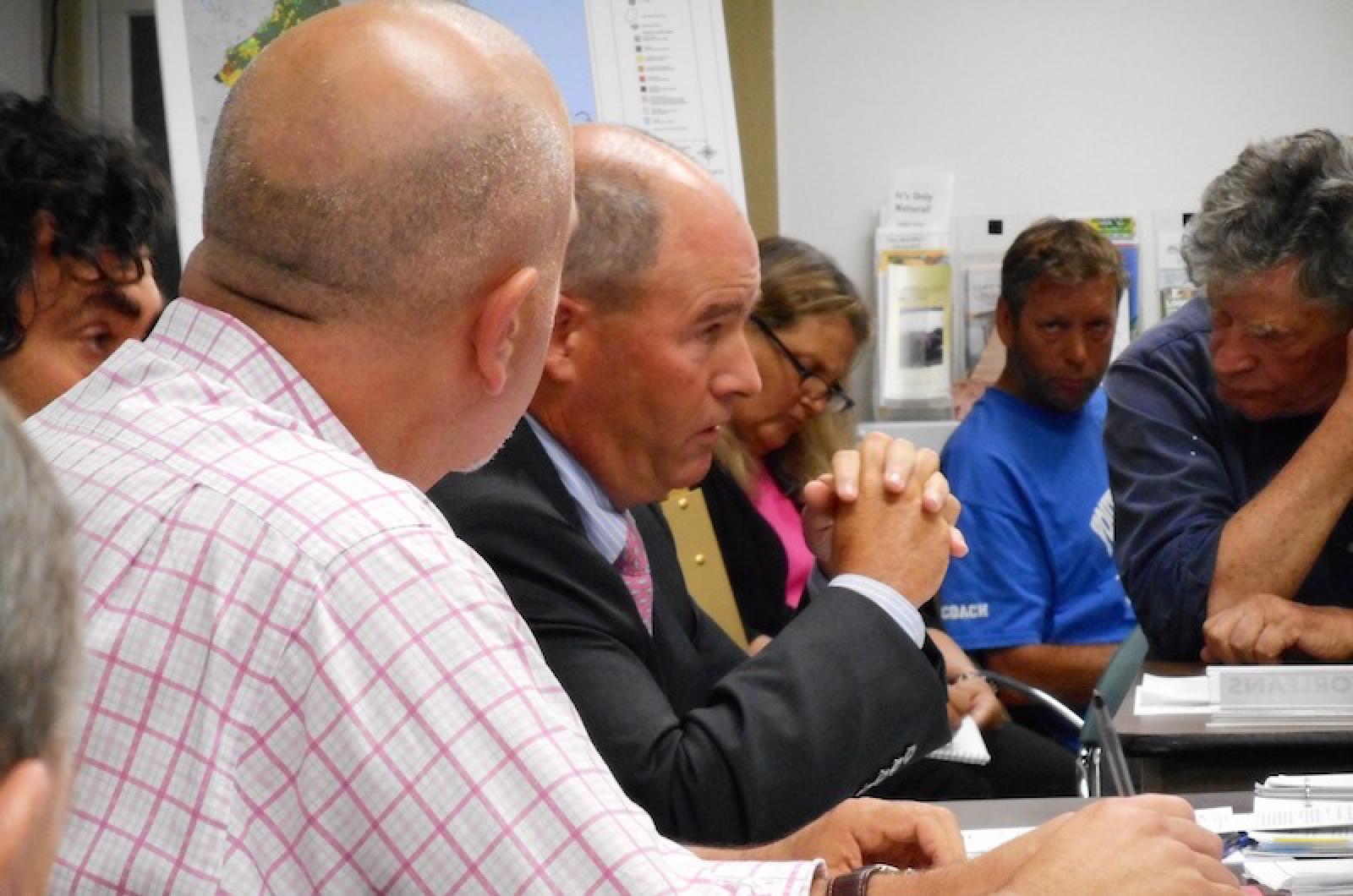A plan by the Oak Bluffs water district to develop the town’s first municipal solar array has come under fire as ecologists and conservationists argue that the project site abutting the Manuel F. Correllus State Forest is better left as ancient woodlands.
A turbulent public hearing before the Martha’s Vineyard Commission late last week touched on issues related to forest ecology, climate change, water quality and the potential benefits of solar power on the Vineyard.
The commission is reviewing the project as a development of regional impact.
The 10.37-acre site on Alwardt Way is part of a larger area owned by the water district that abuts the state forest to the south and the Margaret K. Littlefield Greenlands to the west, an aquifer protection area. The entire 56-acre water district property, dominated by various oak species, is listed by the commonwealth as protected in perpetuity. It was unclear at the hearing last Thursday whether the land is protected by Article 97 of the state constitution, which would require additional review, including a two-thirds majority vote by the state legislature and the governor’s approval.
Water district superintendent Kevin Johnson has said the district, which operates as its own governmental entity, expects to generate energy savings of up to $800,000 over 20 years, allowing for improved facilities and equipment, although it likely will not mean lower water bills for customers.
The project would mark a first for the town of Oak Bluffs, with all other Island towns having established solar arrays in recent years. But it would also be the first solar array on the Island to replace a protected ancient woodland that has remained undisturbed for thousands of years.
The state Department of Environmental Protection (DEP) has conditionally approved the project, which would occupy a zone of contribution for three public wells on the property, along with rare species habitat. The state National Heritage and Endangered Species Program also has given preliminary approval.
The plan was significantly downsized this summer, partly out of concern for protecting wellheads. But opponents argue that water quality and the Island ecosystem would still suffer.
“The greatest thing you can do to mitigate climate change effects is to keep forests intact,” Polly Hill executive director Tim Boland said at the hearing.

Mr. Boland and Harvard Forest director David Foster have gone on record strongly opposing the project, writing letters to the commission in August. Last week The Trustees of Reservations, BiodiversityWorks and Mass Audubon wrote their own letters of opposition to the MVC.
Among other things, conservationists point to a decline in critical oak forests around the world as a result of development and climate change. In one of three letters, Mr. Boland said oaks support more wildlife than any tree species in North America.
In a study commissioned by the water district, civil engineer John A. Edwards of Hadley found the trees in question have “no unique history” on the Island. And a recommendation by Bristol Engineering Advisors Inc of Mattapoisett and Cambridge cited low risk to the groundwater resource, as long as the topsoil remains in place within the 300-foot buffer zone around the wellheads, as proposed.
Sean Murphy, an Island attorney representing the water district, sought to downplay the concerns of ecologists. “In reading these letters, I would think that we are clearing the entire state forest,” he said at the hearing. He displayed maps to illustrate that the so-called zone-two area of contribution covered a wide area including commercial uses.
“Zone two exists throughout the whole Island,” Mr. Murphy said. “So the fact that we would go in there and cut the trees is not going to affect the water quality.”
George Sourati of Sourati Engineering Group in Vineyard Haven, which designed the project, said only the central five acres would be cleared entirely, with underbrush and small trees remaining around the perimeter. But Mr. Boland argued that having to cut those trees repeatedly so as not to block the sunlight would amount to a loss.
He noted that roots and soil in the forest remove pollutants and help maintain the quality of the groundwater. “The area you’re totally going to clear — that’s open and you put grass down — you’re completely wrecking the water quality,” he said.
Mr. Murphy objected.
“This is completely inappropriate,” he said. “We have an expert: Bristol Engineering.”
But commissioner Fred Hancock, who chaired the hearing, defended Mr. Boland as an expert in his field. “We are going to get his opinion when we need it,” he said.
Oak Bluffs selectman Gail Barmakian challenged the argument that additional development wouldn’t affect the zone two, since the water district land had been taken by eminent domain by the town some time ago to protect the aquifer. “To compare it to the rest of the town that is in zone two I think is totally irrelevant and out of context,” she said. “It was basically conservation land.”
Discussion turned to the benefits of solar power, with Mr. Murphy arguing the project would reduce the district’s carbon footprint and benefit the community by keeping water bills from creeping up over time.
BlueWave Capital, which is developing the project, has said the potential CO2 savings would be equal to about 1,081 acres of U.S. forest. But Mr. Boland said the figure, based on national averages, does not take into account the value of living forests.
Marc Rosenbaum, a renewable energy expert and director of engineering at South Mountain Company in West Tisbury, pointed out that the estimated 1.6 million kilowatt hours the project would generate per year was far more than the district needed — a result of its agreement with BlueWave Capital, which plans to sell the remaining electricity through net-metering credits.
BlueWave representative Jon Mancini, who attended the hearing, explained that energy credits would be sold to the water district at a discount, with the rest being offered to the town or nearby community for purchase. “The benefit of that is it’s on-the-Island produced power,” he said, noting the potential savings compared to the purchase of renewable energy credits from the mainland.
Ms. Barmakian said the savings were still undetermined. She and others have pressed for alternative sites, although Mr. Murphy said he was told there were none large enough. Ms. Barmakian said Oak Bluffs has been looking into developing its own solar array at the former town landfill.
The hearing was continued to Sept. 22.
In the interim, the commission plans to seek legal advice on whether the land is protected by Article 97.







Comments (15)
Comments
Comment policy »